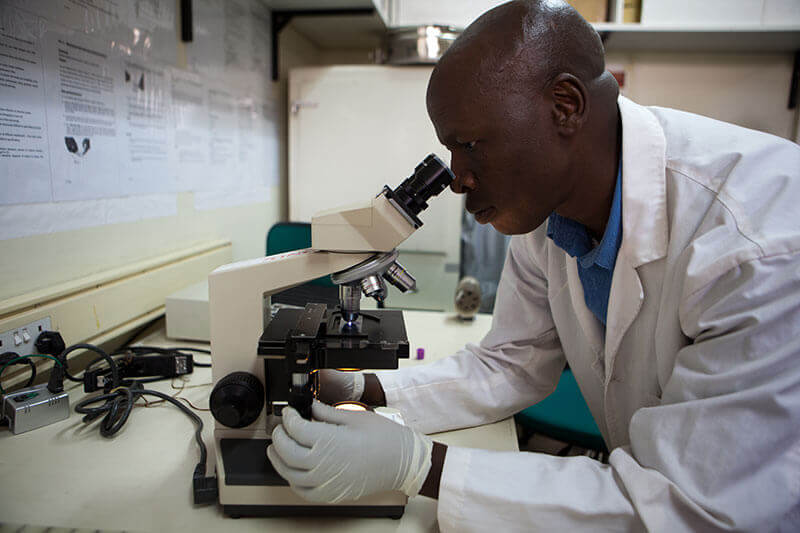The US Government and research and development for neglected tropical diseases: Most neglected patients still falling through the cracks
One billion people. That’s roughly how many people live in North America and Europe combined. And that’s also roughly how many people have at least one neglected tropical disease (NTD).
Rachel M. Cohen, MPP, is the regional executive director of the Drugs for Neglected Diseases initiative (DNDi) North America.
One billion people.
That’s roughly how many people live in North America and Europe combined. And that’s also roughly how many people have at least one neglected tropical disease (NTD).
NTDs, as defined by the World Health Organization, are a set of 17 infectious diseases that severely debilitate or kill people, most of whom are poor, marginalized, or in other ways vulnerable. NTDs such as sleeping sickness and kala azar are 100 percent fatal if left untreated. Parasitic-worm diseases like river blindness and elephantiasis can blind and deform people, young and old. Chagas disease almost exclusively infects those in Latin America, but kills more people in this region than malaria.
The United States Government has played a major role in ensuring that patients with certain NTDs receive urgently needed treatments through the US Agency for International Development (USAID) NTD Program, while simultaneously being the largest funder of basic research for NTDs through the National Institutes of Health. This commitment has spanned several presidential administrations, receiving widespread support from both Democrats and Republicans alike in Congress.
However, today US Government funding for NTDs is under threat. The recently announced US fiscal year (FY) 2013 budget request from the Obama Administration has slashed the USAID NTD Program budget, which was already miniscule at $89 million, by nearly 25 percent to $67 million. That is one of the single largest percentage cuts in global health. This isn’t trimming the fat—it’s cutting into muscle.
While the USAID NTD Program has made an enormous impact for millions of people, the current initiative only focuses on five of the 17 NTDs. It does not fund diagnosis or treatment of the NTDs with the highest death rates —sleeping sickness, Chagas disease, and visceral leishmaniasis—and it does not fund any research into new health tools, unlike every other disease-specific program at USAID.

- USAID must urgently invest in research and late-stage product development for NTDs in order to bring new, life-saving health technologies to patients. Photo: PATH/Evelyn Hockstein.
If the requested budget cuts go through, existing programs will have to be cut, and there will be no room for urgently needed program expansions. This will have direct consequences in terms of lives lost.
The NTD Program budget line needs to be increased to President Obama’s FY 2012 request of $100 million. USAID must also urgently invest in a broader scope of diseases, including the aforementioned deadly NTDs, and in late-stage product development for NTDs in order to bring new, life-saving health technologies to patients.
But why are new drugs needed? Can we not make do with the drugs already available to treat NTDs? In short, no. Here is just one reason.
Today, filarial parasitic-worm diseases (onchocerciasis, also known as river blindness, and lymphatic filariasis, also known as elephantiasis) are treated with the drug ivermectin. But in people co-infected with another filarial disease, African eye worm (Loa loa, or loaisis), this treatment, alone or in combination with another called albendazole, can lead to brain damage—or even death. More than 14 million people are at high risk. For these patients, a new treatment is needed.
My organization, the not-for-profit research and development organization Drugs for Neglected Diseases initiative (DNDi), is developing a drug called flubendazole that, if successful, would be safe and effective in these patients. Without such a drug, control and elimination of river blindness and elephantiasis will not be possible. USAID has publicly committed to contributing to the global goals of elimination and control of these and other NTDs, both through the US Global Health Initiative targets and, most recently, by signing on to the “London Declaration on NTDs” on January 30 at the high-level event “Uniting to Combat NTDs.” But rather than sustaining or expanding its commitment to NTDs, USAID appears to be retreating.
For nearly all other communicable diseases, USAID funds late-stage product development (phase IIb or later), to bring needed innovations through the pipeline and, ultimately, to patients. This is the case for malaria, tuberculosis, and HIV and AIDS, for example. But not for NTDs. USAID must without delay begin investing into late-stage product development for NTDs. This approach would align NTDs with other disease-specific USAID programs that currently allocate a percentage of their funding for late-stage product development, and would be entirely consistent with USAID’s vision of promoting science and technology to advance international development.
In order to bridge the gap between innovation and equitable access to the benefits of scientific research, late-stage product development is crucial. USAID must act now to prioritize the needs of the world’s most neglected patients who urgently need new drugs, diagnostics, and vaccines. Without new tools, these patients will fall through the cracks and die in silence.
